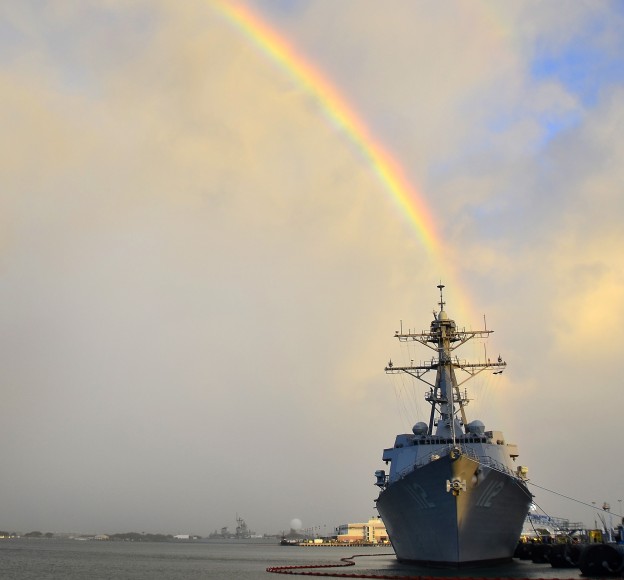
The Navy has awarded $6.1 billion in contracts to Huntington Ingalls Industries (HII) and General Dynamic Bath Iron Works (BIW) for nine Arleigh Burke–class guided missile destroyers (DDG-51) to be purchased between Fiscal Years 2013 to 2017 in a massive multi-year shipbuilding deal, Naval Sea Systems Command told USNI News on Monday.
The contract award has HII building five of the hulls for $3.3 billion and BIW four for $2.8 billion. The multi–year deal — starting with future ships Paul Ignatius (DDG-117) and Daniel Inouye (DDG-118) — includes an option for a tenth DDG-51 if the Navy can overcome a sequestration funding challenge. The extra ship would likely be built in 2014 by BIW, NAVSEA said.
The price per hull comes to $660 million for HII and $700 million for BIW. The cost for the hulls does not include so-called government furnished equipment like radars or combat weapon systems.
The competition for the new hulls was constructed between BIW and HII under a so-called ‘Profit Related to Offers’ scheme.
“By leveraging competition in the DDG-51 class shipbuilding program, these shipbuilders will continue their proud histories in delivering these highly capable ships to the fleet while meeting critical operational requirements for integrated air and missile defense capability,” Secretary of the Navy Ray Mabus said in a Monday statement.
Each yard was required to submit a base cost for the ships along as well as a projected profit margin. HII victory means the company will receive the base price and its proposed profit margin for the ships while BIW will receive the base price for its four ships and a lower profit percentage.
“This contract award and, importantly, the Navy’s structuring of the program increases our momentum in realizing efficiencies generated from true serial production,” said HII’s DDG-51 Program Manager George Nungesser in a statement provided to USNI News.
BIW did not provide a USNI News a statement as of this posting.
The plan calls for the nine or ten ships to be built as current Flight IIAs, according to NAVSEA. But the service will execute a so-called engineering change to develop three hulls as a Flight III design, “once Flight III requirements are approved,” NAVSEA said.
Flight III ships will be the first U.S. Navy ship class designed with a native ballistic missile defense capability.
The first Flight III is anticipated to be the second ship procured in 2016 and be built by BIW as part of the multi-year deal, according to NAVSEA.
Under the nine-ship deal, the first Flight III would be designated DDG-123 while under the ten-ship deal the first Flight III would be DDG-124.
For the three Flight III ships in the multi-year deal, the Navy will face the challenge of incorporating the Navy’s new Air and Missile Defense Radar (AMDR) — currently under development — into the 30-year-old hull of the Arleigh Burke.
The AMDR plans to be a 14 ft. aperture S-band radar (ballistic missile defense and air defense), X-band radar (horizon search) and radar suite controller that will replace the current Lockheed Martin SPY-1D radar found on the current Flight IIAs.
Currently Lockheed Martin, Northrop Grumman and Raytheon are in the running for the final S-band and radar controller design for AMDR with an award selection anticipated this summer. The Navy plans to pursue the X-band component in a separate competition.
The DDG-51 Flight III program was born as a compromise between the high cost of a new surface combatant and the extension of the Burke Flight IIA program. The Burkes are built around the Aegis missile system. Aegis — designed to counter anti-air threats — has been the centerpiece of the Navy’s large surface combatants since the 1980s. Improvements some in some Aegis ships — additional processing power, improved software and new missiles — have allowed the system the capability to combat ballistic missile threats.
Recently, members of Congress and the Government Accountability Office have called into question the ability for the Flight III program to be able to handle the requirements of AMDR and be able accommodate high power weapons systems like electromagnetic rail guns and high-power directed energy weapons.
The GAO found in 2012, “the inclusion of the AMDR on the existing DDG 51 hull to significant risks in the ship’s design and a reduced future capacity and could result in design and construction delays and cost growth on the lead ship.”
Additionally, a 2011 NAVSEA report found the power and requirements cooling requirements for a notional X and S band AMDR would require five times more power and ten times more cooling than the current SPY-1D. However improved radar technology since NAVSEA set its baseline could have reduced power and cooling requirements.





